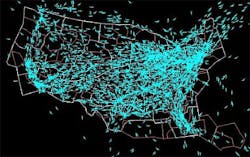NASA Ames researchers said Monday they plan to issue a request for proposal (RFP) by 1 May 2013 for the Shadow Mode Assessments Using Realistic Technologies for the National Airspace System program -- better-known as SMART-NAS.
The program seeks to enable plug-and-play of different technologies to operate in real and virtual ways to explore alternative concepts, technologies, and architectures for the U.S. National Airspace System, which is among the most complex systems for controlling commercial, military, and general aviation aircraft in the world.
NASA researchers ask industry to identify and develop open-source architecture alternatives for a SMART-NAS capability; propose architecture concepts; conduct benefits assessments of SMART-NAS capability; estimate costs for SMART-NAS technologies and maintenance; and identify ways to develop an operational SMART-NAS capability.
Although the current National Airspace System is a complex, efficient, and safe system, NASA and the FAA are developing new concepts and technologies for the Next Generation (NextGen) Air Traffic Management (ATM) system to increase the capacity of airspace, reduce delays, and reduce the cost of ATM operations, NASA researchers say.
Current modernization of the NAS is based on evolutionary changes; only one or two major system or technology upgrades are introduced at a time to ensure seamless integration and transition. Developing NextGen, however, will change all that, and NASA needs simulations to test-drive new concepts.
There are significant technical risks of inserting several technologies simultaneously, experts say. Today there is no capability for testing and validating advanced concepts, algorithms, human-automation, air-ground architectures, and their interactions at the entire NAS level using real operational data.
NASA researchers say they expect to award several two-year contracts for the SMART-NAS program. The RFP should be out by 1 May, and contracts are expected by 30 Sept. 2013. A Microsoft Word draft statement of work for the upcoming SMART-NAS solicitation is online at http://prod.nais.nasa.gov/eps/eps_data/155927-DRAFT-001-001.docx.
For questions or concerns contact Christine Martinez, the SMART-NAS contracting officer, by phone at Phone 650-604-5807 or by email at [email protected].
More information is online at https://www.fbo.gov/spg/NASA/ARC/OPDC20220/NNA13469771R/listing.html.



